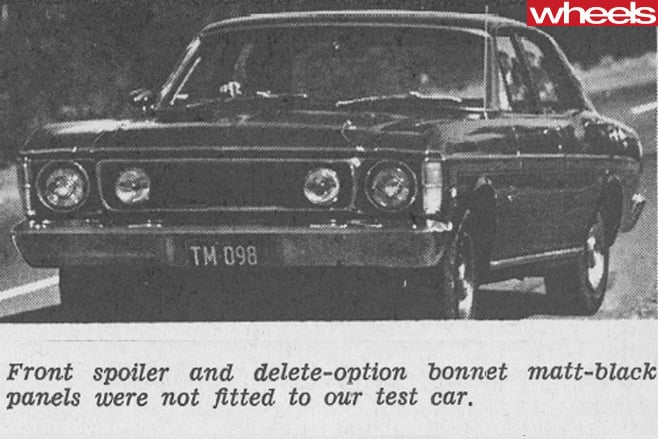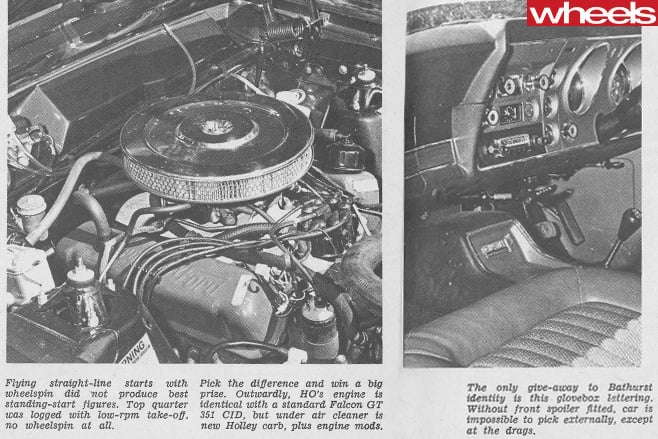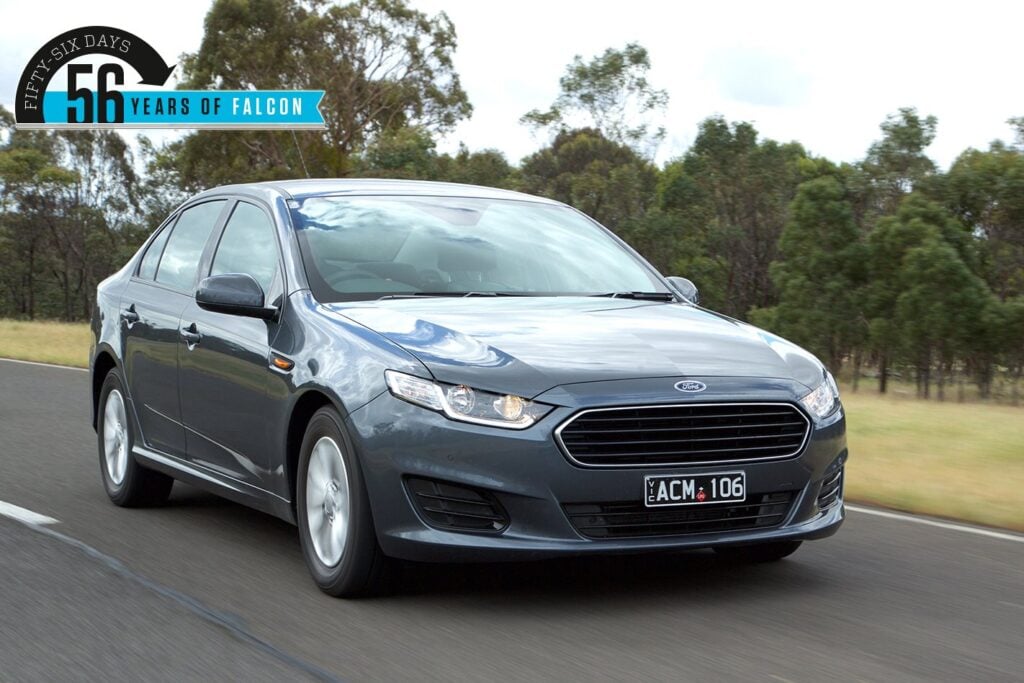First full test of Ford Motor Company’s ultimate sixty-niner …
First published in the November 1969 issue of Wheels magazine, Australia’s best car mag since 1953.
Cleverly disguised behind the cute term HO for Handling Option, Ford’s Super GT is actually a Bathurst race special, designed specifically to go up the Mountain and along the top, faster than any other car in the race.
FORCED into a corner by some Sydney daily newspapers, Ford attempted to ignore completely the existence of the new Falcon GT HO.
Some writers gave the impression the Super Falcon is capable of a top speed somewhere between 160 and 180mph.
Ford and every sane-minded motoring-conscious motorist know this is ridiculous. But Ford wasn’t about to prove it to anybody. The company refused point-blank to provide a test car for journalists in either Sydney or Melbourne, and in the early stages even denied the cars were available.
However, WHEELS lined up several privately-owned or dealer-owned cars to test, but most had insufficient miles up. Our test car finally came from a privateer, Trevor Meehan, well known up until a year ago for his spectacular, clean and successful record on the race-track, particularly in Cooper S type vehicles.
Meehan intended returning to the track in the HO in this year’s 500, but also cross-entered a Mini Cooper S. Disappointed at some aspects of the Falcon’s required preparation and trim for the race, and encouraged by better odds in Class C, Meehan withdrew the HO the day before our test and let the Cooper entry stand. With only a handful of rival Cooper S types in the class, he figured on a good chance at Class victory, with a possible outright win on the cards should it rain. Since this magazine will sell on the bookstalls throughout October as well as before the race, we aren’t going to speculate on that.

If we had driven the GT Falcon earlier than we did, we would have immediately assumed the existence of a Bathurst special well before its first publicised release, because the standard car just isn’t an improvement (race-track performance-wise) on the previous year’s model and clearly didn’t stand an outright chance at Bathurst against the 350 GTS.
The HO is different again. It is a pure, outright and unashamed Bathurst special. It is manufactured by Ford to a quantity of exactly 201 cars (Ford may tell us there will be a second batch, as they did with the GT 500 Cortina which never arrived, but frankly we don’t believe them).
The car’s engine and suspension were designed with a relief map of Mount Panorama in the Engineering Department, and the car was built around racing tyres.
Apart from conclusions drawn from gear ratios, we can’t tell you a great deal about the background to the Ford’s engine improvements.
The factory states that “detail improvements” include a 600 cubic foot per minute Holley carburettor, aluminium inlet manifold, and improved camshaft and hydraulic lifters.
However we could not obtain specific power or torque output figures, or determine other factors like compression ratio, from the factory. For this reason we haven’t provided a specifications chart with our performance panel.
To look at, the car is identical with ordinary GTs. Our test car did not have the front spoiler fitted and could only be picked as a HO by the day-glo pink lettering on the glovebox – GT HO. There is nothing on the exterior to give it away, and the engine carries no special markings. It looks so standard that the car went through a full Motor Transport registration without anybody realising it was not an ordinary Falcon GT.
In most respects, the performance is also similar, and without the giveaway glovebox lettering you could put almost any driver in the steer seat and defy him to pick the differences from the Ford Falcon GT.
We got absolutely no indication until we looked at our watches, which was the ultimate build-up because we nearly did a double take when we read them. The car’s top end performance has been so accurately tuned to Mt Panorama’s demands, you would almost swear Ford had a simulated Hill somewhere in its proving grounds.
This car’s engine has been built solely to go up the mountain faster than any other car, and stay quicker along the top. This is the area which racing experts have claimed, ever since the first 500 was run at Bathurst, would win the race for the car tuned to it. Ford has tuned its car to go up that mountain first and fastest every time.
Top end torque is, quite frankly, almost unbelievable. We ran our times over and over, convinced we were making a mistake, but came back every run with. consistent figures.
We recorded a best standing quarter mile time of 14.4 seconds, and only once exceeded the 15.0 seconds mark – due to using wheelspin on the start. The GTS Monaro returned a best 15.6. Even more shattering was the 0-100 mph figure, which averaged out at 16.7 seconds, almost 10 seconds better than the same figure for the automatic Falcon GT, and a full two seconds up on the Monaro GTS. Similarly 0-90 turned up in 14.4 as against the auto GT’s 21.0, and the Monaro’s 15.2.
Starting from identical low-level acceleration times (0-30 2.8, 0-40 3.9) that puts the Holden at a definite disadvantage at the top end of the acceleration scale – or up the mountain.

For what it’s worth, the Monaro has better acceleration when held in the upper gears from 20-40, 30-50 etc, but this doesn’t count for much except general road performance.
Gearing and gear maximums are the really telling features of performance. The HO uses a 3.0 to 1 final drive compared with the standard GT’s 3.25 diff and the Monaro’s 3.36, though there was some speculation the Bathurst Monaros would run a diff as high as 2.7. However, the 3.00 ratio is the one the Fords will run at Bathurst and it has had a definite effect on the performance and the gear spacings.
Since the gearbox ratios are the same, there is a drop in their maximum speed at the same rpm compared with the standard car. The H0 runs to 40 in 1st (47 for the GT), 62 in second (68), and 90 in third (94), all at 5500 rpm, which enables the car to utilise the best features of the power and torque curves.
In top gear we read 130 mph on the speedo (which corrected to 128 mph) but showed 5500 on the tacho.
Clearly the tacho was inaccurate by 600 rpm if Ford’s mph-per-1000-rpm-in-top figure of 26 is to be believed.
Ford gives a maximum usable rpm limit of the engine as 6000, which means both that the car will probably accelerate even faster than our figures, and that the actual gear maximum and top speed capabilities are much higher.
We purposely didn’t exceed 5500 at any time and held that point at 128 mph all through our flying quarter-mile top speed run with well over an inch of throttle free-play to use.
It doesn’t take a slide rule to work out that 26 mph-per-thou at six grand is 156 mph, which probably explains where one newspaper got the story of a 160 mph GT Falcon. Obviously a car as big as that can’t push a solid wall of air rapidly approaching eight tons per square inch, and we’d put 135-138 mph as the sane limit, even on Bathurst’s Conrod.
The Ford’s front spoiler also comes into the top speed reckoning. Our test car was not fitted with the plastic (yes – plastic) spoiler and didn’t feel any worse for its omission, but two identical cars tried privately at Surfers – one with/one without the front spoiler – had a front end attitude down the straight of some six inches difference. Both on the road and on the track our test car felt safe and stable without it, but Conrod is a different place again.
However, we can’t help thinking that the Conrod humps, and the sudden surge of air they produce under a front end, could make an unhappy combination with such crude spoilers.
None of our staff actually put the car through its maximum track paces. We decided against this because we saw nothing to gain from it. Better men than us (including some of Australia’s top drivers) had been around Sydney’s Oran Park in a best of 59 seconds (which is not good) experiencing total brake fade at embarrassing points of the circuit on the way.
Our test car had actually recorded the top Oran Park time as this story went to press, and we were quite content to let this record stand. However, it is obvious the Falcon is not suited to such a course.
Fine on the open road, and apparently carefully suspension-tuned to Bathurst, the big GT is a fair bitch on a tight circuit like Oran. Every driver we know who has tried the car had either had a lose or been off the circuit, without bettering even standard GT times, or approaching Monaro GTS times, which have been set in the low 57s.
Bathurst again is different and the ultra-stiff rear roll bar which makes for a twitchy tail, excessive wheelspin and brute oversteer on tight Oran, may be just fine for running along the ridges at Panorama at over the ton.
In standard ex-factory trim, the big Kelsey Hayes ventilated discs just don’t work. They fade worse than any disc system we have tried, and are particularly ineffective after a series of high speed crash stops. However, we’re equally convinced this situation will be corrected on the Bathurst HOs.

Unconfirmed as yet by a dealer, we also hear some brake components have been modified. Impending brake modifications are hinted at in the Blueprinting Bulletin for the HO and we believe sintered metallic linings for the rear drums will be mated to the specially developed Hardie Ferodo new pad compound.
New roll bars may be homologated and a stiffer spoiler is being produced for Bathurst cars.
In the case of the HO, there was considerable competitor unrest among entrants of these cars, at the time of writing this article, as there appeared to be discrepancies between the works and private cars: Privately-owned cars apparently won’t accept racing tyres (Firestone has tried to fit them), although the factory cars are known to be running them (Goodyears). (However Michelin XAS were used at Sandown.) Factory-homologated options of the type issued late last year by GM-H are likely to become necessary before the cars will be running in full race trim.
As a direct contradiction, Ford provided a very comprehensive “Blueprinting Specifications” instruction bulletin. Among the items cited for recommended attention were: crack testing of pistons; pins, rockers/pivots, crankshaft, main bearing caps/bolts, camshaft timing gear, distributor gear, flywheel/bolts/pressure plate and clutch face; balancing (dynamic and static) of pistons/pins, conrods, crankshaft; pulley, flywheel, pressure plate; lining; adaptor; factory fine tolerance clearings to be blueprinted for everything from conrod side clearance to spark plug and contact point gap, including combustion chamber volume (milling if necessary) deck height, valve seat angles, valve spring pressures/height (shims necessary also listed) cylinder bore clearance and so on. The bulletin also covered all oils, lubricants and fluids, plus brakes, wheel bearings and roll bar settings.
The bulletin is marked “strictly confidential”, but is substantially elementary as far as dead-serious regular Series Production preparation is concerned. Fine tuning, detail preparation and all the other factors which play into race-winning competition are not elementary. Only with the right knowledge and combination of factors can you win. That is the story of Bathurst.
***
Ford scored a psychological advantage over The General with a one-two-three win in the Sandown Three Hours in mid-September. Moffat/French put their HO over the line a clear lap ahead of Roddy/Carter and McPhee/Mulholland-both privateers. The other two Ford factory team cars and the single Holden Dealer team entry suffered major troubles. The Geoghegan/Geoghegan car was pranged by Big Pete while working his way through the field from a rear-of-the-grid start, and the Setoni/Gibson HO suffered fractured tyre valves which put it back to fourth overall. The Holden 350 GTS driven by Spencer Martin went through the fence, flipped and caught fire after total loss of brakes on Shell. But Sandown is no lesson for Bathurst.
Check out Wheels Archive online now for other great Ford Falcon features and more from decades past!
Simply log in here using your existing MagShop account or create a FREE account and select this article from the homepage.
Don’t have a MagShop account?

Have a MagShop account?






